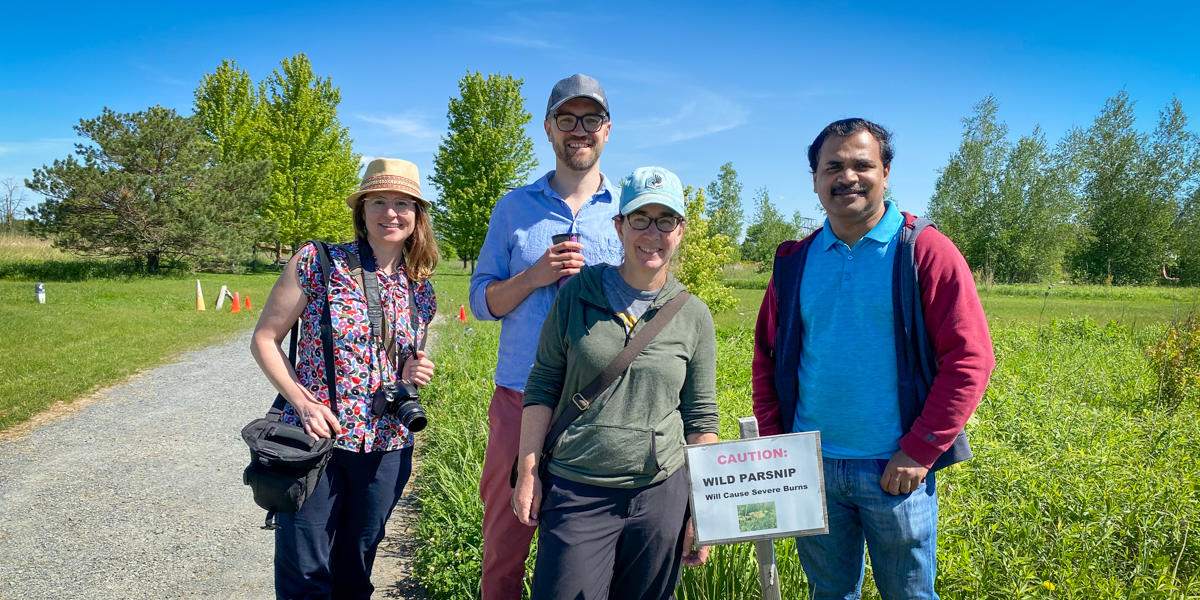
Research team members
Background
Understanding plant phenology is important for predicting the annual timing of key plant growth stages like flowering or seed development, which are controlled by environmental factors like temperature and sunlight availability.
Currently, management activities tend to use calendar days for predicting phenology and timing of management. However, phenology is strongly regulated by temperature. Thus, scheduling management using temperature-based predictions of phenology could be more effective.
This research team sought to develop better information on the timing of life cycle events and how they relate to temperature on two priority invasive species: wild parsnip (Pastinaca sativa) and Japanese knotweed (Polygonum cuspidatum).
Research questions
- How do temperature and photoperiod affect the phenologies of wild parsnip and Japanese knotweed in Minnesota?
- When are important phenological events for wild parsnip and Japanese knotweed likely to occur in different parts of Minnesota?
Outcomes
Montgomery and her team developed climate-based phenology models of key phenological events such as flowering and fruiting. To collect data for the models, they created and nurtured a robust citizen science network called Pesky Plant Trackers. In addition, there were 5 University field plots across Minnesota from which they collected data. Overall, they trained 96 volunteers; 80 contributed data on 255 plants (180 planted) or patches of plants located at 64 sites.
Phenological data on Japanese knotweed and wild parsnip is available on USPests.org along with a guide on how to use the data (see project artifacts). Land managers can use the data to estimate phenology of these species given current and projected seasonal temperatures.
Project artifacts
- USPest data model for Japanese knotweed and wild parsnip
- Guide for using the USPest models (pdf)
- How to use Japanese knotweed phenology data to inform management decisions (pdf)
- How to use wild parsnip phenology data to inform management decisions (pdf)
Outreach
- Pesky Plant Trackers citizen science program, online training module, and monthly newsletter
- Pesky Plant Trackers YouTube channel
- Contributor to Annual report from USA National Phenology Network
- Invasive Species Conference at UMN Research and Outreach Centers, 2022
- Mentored UMN Master-Naturalists-in-training for capstone projects, 2022
- UMN Gathering Partners Conference, 2021, 2023
- “Annual Short Course” for Minnesota Association of Country Agricultural Inspectors, 2021
- Open Lands Chicago, 2021
- Anoka County Master Gardeners gathering
- Citizen Science Association of America
- Franconia Sculpture Park event
News and media
- Phenology data tool helps optimize timing of invasive plant management (MITPPC, 2024)
- Featured in the USA-National Phenology Network annual report
- Pesky Plant Trackers - In Vermont! (Vermont Invasives, 2023)
- Abbie Anderson and Stephan Carlson with the Pesky Plant Tracker Program (KAXE radio, 2021)
- University of Minnesota seeks volunteers for Pesky Plant Tracker program (Bemidji Pioneer, 2021)
- Grow with KARE: Wild parsnip (KARE 11, 2020)
- Pesky Plant Trackers (Nature’s Notebook webpage)
- Meet the Researcher: Byju Govindan